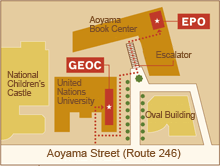Overview
Production forests and protected forests can be managed by the community by giving right of individuals over protected forest land. Since 2007, the Indonesian government issued a policy on a Community Forestry Program (HKM) which stated that both production forests and protected forests can be managed by local communities, the public is given the right of individuals over protected forest land as long as the forests are managed with a multi-strata system (planting forests in accordance with elevation levels – from the low, medium to the highest level. Communities are also required to conduct water and soil conservation, and to protect forest areas.
With support from NGOs such as ICRAF (International Center for Research in Agroforestry) and International Fund for Agricultural Development, the concept of PES is introduced through the project RUPJL (Rewarding Upland Poor for Environmental Services They Provide) to communities in the region. RUPJL conceptualizes three proposed reward mechanisms:
– First, payment schemes for environmental services that involve the state electricity company as a purchaser of watershed environmental services.
– Second, the management rights of land as reward mechanisms for watershed protection projects and carbon sequestration. As rewards to providers of environmental services, the Department of Forestry issues permits for public land use. Local communities and governments negotiate legal rights of land use, as a reward for better forest management. ICRAF and local NGOs are to help communities develop the community forestry scheme.
– Third, mechanisms developed to improve the quality of water for domestic use, by introducing the possibility of direct payments.
*Sumber Jaya is a district located in West Lampung Province in which 40% of the area is protected forest area and 10% is national park.
Points about the partnership
-An evaluation of PES in Sumber Jaya shows it is quite promising and has good prospects in terms of impact on forest conservation; this is apparent from the increased amount of dense forest, decreased illegal logging, and an increased level of public awareness of the importance of managing forests sustainably;
-To develop monitoring and evaluation mechanisms, both parties were assisted by ICRAF, particularly in setting up criteria and indicators river care programs. The criteria consist of physical, social and economic dimensions;
-ICRAF and local NGOs help communities develop the community forestry scheme;
-The social forestry scheme generally known as “HKM” or “Hkm” (hutan kemasyarakatan) gives farmers land tenure for planting in protected forest. In return, farmers undertake agricultural activities that are more environmentally friendly, and help protect the remaining natural forests, so that forest land will continue to provide a protective benefit to improve the sustainability of the water supply. HKM programs accounted for 70% of the protected forests in Sumberjaya, involving 6,400 farmers and 13,000 hectares of forest area;
-The sources of funds for the hydroelectric power plant are corporate CSR programs, and an environment management fund.
The figure
-Above is a schematic RUPJL in West Lampung. The PES schemes in Sumber Jaya not only involve cash money, but also other forms of support such as a revolving fund for goat farming and fish farming cultivation, the development of micro-hydro installations, and tree seeds. The sources of funds for the hydroelectric power plant are corporate CSR programs. An evaluation of PES in Sumber Jaya shows that this scheme is quite promising in terms of impact on forest conservation; this is apparent from the increased amount of dense forest, decreased illegal logging, and an increased level of public awareness of the importance of managing forests sustainably.
Category
□Project cooperation/project accord
Theme
□Forest preservation □Biodiversity/nature
Actor
Indonesian Ministry of Forestry
Partners
ICRAF and local NGOs


















